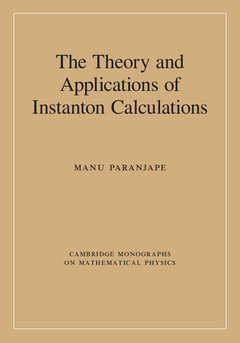Description
The Theory and Applications of Instanton Calculations
Cambridge Monographs on Mathematical Physics Series
Author: Paranjape Manu
This book explains in detail the key concepts, calculations and applications elucidating quantum tunnelling mediated by instantons, using the Feynman path integral.
Language: English
Subject for The Theory and Applications of Instanton Calculations:
Publication date: 11-2017
322 p. · 18.3x25.4 cm · Hardback
322 p. · 18.3x25.4 cm · Hardback
Description
/li>Contents
/li>Biography
/li>
Instantons, or pseudoparticles, are solutions to the equations of motion in classical field theories on a Euclidean spacetime. Instantons are found everywhere in quantum theories as they have many applications in quantum tunnelling. Diverse physical phenomena may be described through quantum tunnelling, for example: the Josephson effect, the decay of meta-stable nuclear states, band formation in tight binding models of crystalline solids, the structure of the gauge theory vacuum, confinement in 2+1 dimensions, and the decay of superheated or supercooled phases. Drawing inspiration from Sidney Coleman's Erice lectures, this volume provides an accessible, detailed introduction to instanton methods, with many applications, making it a valuable resource for graduate students in many areas of physics, from condensed matter, particle and nuclear physics, to string theory.
Preface; 1. Introduction; 2. Quantum mechanics and the path integral; 3. The symmetric double well; 4. Decay of a meta-stable state; 5. Quantum field theory and the path integral; 6. Decay of the false vacuum; 7. Large orders in perturbation theory; 8. Quantum electrodynamics in 1+1 dimensions; 9. The Polyakov proof of confinement; 10. Monopole pair production; 11. Quantum chromodynamics (QCD); 12. Instantons, supersymmetry and Morse theory; Appendix A. As aside on 0(4); Appendix B. Asymptotic analysis; Bibliography; Index.
Manu Paranjape has been a professor at the Université de Montréal for the past thirty years. In this time, he has worked on quantum field theory, the Skyrme model, non-commutative geometry and conformal gravity. Whilst working on induced fermion number, he discovered induced angular momentum on flux tube solitons, and more recently he discovered the existence of negative mass bubbles in de Sitter space, which merited a prize in the Gravity Research Foundation essay competition.
© 2024 LAVOISIER S.A.S.




